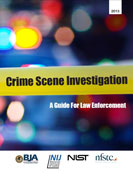|
View in browser: https://www.crime-scene-investigator.net/newsletter/1218.html
|
||
|
DECEMBER 2018 | ||
| ||
|
This Month's Featured Resource on the Crime Scene Investigator Network Website
|
||

This updated Crime Scene Investigation: A Guide to Law Enforcement is a revision of the original publication published in January 2000, and borrows heavily from that work. The resulting document includes detailed procedural guides for the complete range of crime scene investigation tasks — from securing the scene to submitting the evidence. This publication provides law enforcement professionals and first responders step-by-step guidance in this crucial first phase of the justice process. |
||
|
New CSI and Forensic Job Announcements
|
||
|
The most comprehensive listing of Crime Scene Investigation and Forensic To be notified of job openings as they are posted, follow us on Twitter: Job Posting Alerts |
||
|
Crime Scene Technician
Fort Walton Beach Police Department, Fort Walton Beach, Florida, USA Final Filing Date: January 4, 2019 Performs non-sworn law enforcement work involving receiving, handling, recording, packaging, storing, transporting, maintaining, protecting, and disposing of all physical evidence for the Police Department. Work is performed under the general supervision of a Criminal Investigations Supervisor. <View complete job listing> |
||
|
Forensic Examiner I or II
Rapid City Police Department, Rapid City, South Dakota, USA Final Filing Date: January 6, 2019 Responds to major crime scenes; collects and analyzes evidence; preserves and documents crime scene and evidence through photography, measuring and scale drawings; prepares written reports. Operates analytical equipment and instruments using standard technical and scientific methods to perform specialized forensic examination of evidence and prepares written reports. <View complete job listing> |
||
|
Crime Scene Specialist
Tucson Police Department, Tucson, Arizona, USA Final Filing Date: January 13, 2019 Conducts forensic crime scene investigations. Documents crime scenes, physical injuries, victims, suspects, and evidence through the use of forensic photography and laser based mapping technology. Assesses, collects, packages and preserves evidence to include latent fingerprints, physical evidence, and biological evidence such as blood, hair, and bodily fluids. Safely contains all bio-hazardous materials for transport to evidence storage area. Photographs and obtains fingerprints at postmortem investigations. Records actions taken through the use of written reports. Provides expert courtroom testimony. <View complete job listing> |
||
 |
||
|
Forensic Scientist I, II, III
Kansas Bureau of Investigation Forensic Science Laboratory, Topeka, Kansas, USA Final Filing Date: January 4, 2019 You will be expected to perform qualitative/quantitative analysis of drug evidence, paraphernalia and pharmaceuticals using chemical, microscopic and instrumental identification techniques, you will write lab reports, testify in court as an expert witness, and perform general laboratory duties. <View complete job listing> |
||
|
Forensic Scientist Trainee - Controlled Substances
Virginia Department of Forensic Science, Manassas, Virginia, USA Final Filing Date: November 25, 2018 The Virginia Department of Forensic Science is seeking an individual to train to perform forensic chemical analyses of suspected controlled substances. Once trained and qualified as a Forensic Scientist, duties of this position will include: Use current state-of-the-art methodologies and instrumentation to analyze controlled substances; Prepare Certificates of Analyses on findings for use by the criminal justice system; Testify in court as a qualified expert for the Commonwealth at criminal proceedings as to the results of laboratory findings and perform other duties assigned. <View complete job listing> |
||
|
Property and Evidence Technician
Old Dominion University, Norfolk, Virginia, USA Final Filing Date: January 18, 2019 Collects, processes and maintains the chain of custody for all evidence related to crimes. Responsible for collecting, inventory, processing, safeguarding, and presenting evidence, preparing reports, and other administrative duties. <View complete job listing> |
||
|
Search for more job listings in Crime Scene Investigations and Forensics To be notified of job openings as they are posted, follow us on Twitter: Job Posting Alerts |
||
|
Other Resources on the Crime Scene Investigator Network Website
|
||
|
Not Subscribed to this Newsletter?
|
||
|
If you are not subscribed to this newsletter, you may subscribe with this link: SUBSCRIBE via email |
||
|
To Unsubscribe
|
||
|
To unsubscribe from future e-mail newsletters, please click here: UNSUBSCRIBE Copyright ©2018 Crime Scene Resources, Inc. Crime Scene Investigator Network |


